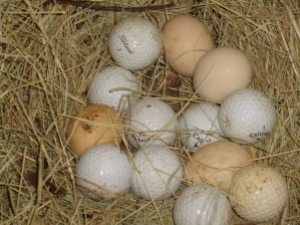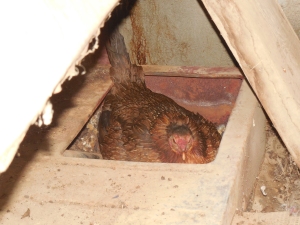In between feeding the livestock, moving the temporary fencing, checking the permanent fencing, fixing water pipes and other chores, caring for the chickens is a fun challenge for Connie at Grieb Ranch.
Connie especially enjoys finding the wild chicken hen’s hidden nests. She also comes across wild duck nests.
Connie switches out the unfertilized eggs for golf balls so that predators do not get the eggs. 
She then waits for the hen to “go broody” – where the hen does not leave her nest even at night. Usually wild hens lay about 16 eggs before they “go broody”. Once about 12 eggs are laid, Connie arranges to place only fertilized eggs in the nest. She gets the fertilized eggs from her neighbor and uses the unfertilized eggs at home. If she is unsure she just guesses that the Rooster did his job.
Connie tries to reset the nest in a safe location that is well-ventilated, free from extreme temperature, and sheltered from the wind and rain the first night the hen “goes broody”. To help transition the hen and her nest with the fertilized eggs Connie encloses them in a box or drapes an old horse blanket over an open box for 24 hours. This helps the hen feel secure in her new location. The next day the hen and her fertile eggs are left uncovered. Connie then marks the calendar for 21 days and waits for the results. If the hen does not settle well in her new location the chicks will hatch out after 21 days and the hen may not be sitting on the nest anymore.
The results are lots of little chicks or ducklings pecking their way out of their shell enclosures and entering the big world.
Baby Chick Rescue – upcoming: pictures of a real chick hatching out –
This year some chicks have had difficulties getting out of their shells (no idea why) so Connie has her Baby Chick Rescue Kit on hand at all times.
The Baby Chick Rescue Kit Contains:
Medium-size “ER” Box (Connie likes filing boxes as the handles make moving it easy)
Heating Lamp
Cage Thermometer
Heating pad
Linen Towel
Bottle caps for feed and water
Connie helps chicks who are stuck in their shells by getting them out and placing them in the ER box. Also chicks that are kicked out early as the hen waits for more eggs to hatch need to be placed in the ER box. She has a heat lamp and a heating pad for the chicks as maintaining proper temperature of 90-95 degrees is vital. Draping a linen towel in tunnel-like shapes allows the chicks to find the warmth or coolness they need to keep their proper temperature.
Chicks revived by the ER box are then placed back in the nest under the cover of night. Usually the time in the ER is until night of the day they hatch, but sometimes it is as long as 36 hours. It is a joy to see new life spring from the nest and watch the chicks grow.
A duck egg was placed in a chicken’s nest because the duck gave up her nest.








